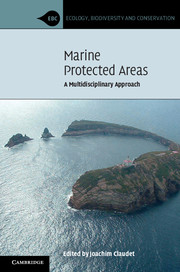Book contents
- Frontmatter
- Contents
- Contributors
- Introduction
- Part I Threats to marine ecosystems and resources
- Part II Effects of marine protected areas
- Part III Assessment of the effectiveness of marine protected areas
- Part IV Scale-up of marine protected area systems
- 11 NETWORKS – The assessment of marine reserve networks: guidelines for ecological evaluation
- 12 CONNECTIVITY – Spacing a network of marine protected areas based on connectivity data
- 13 REPRESENTATIVENESS – Effectiveness of the global network of marine protected areas
- 14 MISSING DIMENSION – Conserving the largest habitat on Earth: protected areas in the pelagic ocean
- Index
- References
13 - REPRESENTATIVENESS – Effectiveness of the global network of marine protected areas
from Part IV - Scale-up of marine protected area systems
Published online by Cambridge University Press: 05 August 2012
- Frontmatter
- Contents
- Contributors
- Introduction
- Part I Threats to marine ecosystems and resources
- Part II Effects of marine protected areas
- Part III Assessment of the effectiveness of marine protected areas
- Part IV Scale-up of marine protected area systems
- 11 NETWORKS – The assessment of marine reserve networks: guidelines for ecological evaluation
- 12 CONNECTIVITY – Spacing a network of marine protected areas based on connectivity data
- 13 REPRESENTATIVENESS – Effectiveness of the global network of marine protected areas
- 14 MISSING DIMENSION – Conserving the largest habitat on Earth: protected areas in the pelagic ocean
- Index
- References
Summary
Introduction
Marine biodiversity is increasingly being lost due to human-related activities. Several marine ecosystems such as estuaries (Lotze et al., 2006), mangroves (Valiela et al., 2001), seagrasses (Waycott et al., 2009), coral reefs (Gardner et al., 2003; Pandolfi et al., 2003; Bruno and Selig, 2007), and coastal and oceanic fish communities (Jackson et al., 2001; Worm et al., 2005) are rapidly losing populations, species, or entire functional groups due to threats such as exploitation, habitat loss, and climate change, among others (Jackson et al., 2001; Hoegh-Guldberg et al., 2007; Mora et al., 2007; Mora, 2008). The rate of these losses and extent of these threats are expected to drive many marine species to collapse and possible extinction before the middle of this century (Worm et al., 2006; Hoegh-Guldberg et al., 2007; Donner, 2009). These losses, in turn, may impair the capability of ecosystems to cope with natural and anthropogenic impacts and harm the services that biodiversity provides to a growing human population that increasingly uses coastal habitats and marine resources (Worm et al., 2006; Donner and Potere, 2007).
The accelerated decay of ecosystems is a modern concern to humankind and has motivated concerted global efforts such as the Convention on Biological Diversity, which was endorsed by more than 190 countries and aimed to reduce the rate of biodiversity loss by 2010 (Balmford et al., 2005). In practical terms, one of the solutions that was proposed and that has received significant support to reverse the loss of biodiversity is the establishment of protected areas (Lubchenco et al., 2003; Balmford et al., 2005; Chape et al., 2005; Lubchenco et al., 2007; Wood et al., 2008). The expected effect of protected areas is that by reducing pressures from harvesting and habitat loss, wild populations will recover if they have been impacted or will maintain natural levels of resilience to cope with natural and other human-related disturbances (Lubchenco et al., 2003; Palumbi, 2003; Micheli et al., 2004; Palumbi, 2004). The fact that such an expected effect has been documented (Halpern and Warner, 2002; Micheli et al., 2004; Worm et al., 2006) and that governments need to fulfill international agreements (Balmford et al., 2005; Wood et al., 2008), has resulted in a proliferation of marine protected areas (MPAs). Today, 4435 MPAs exist worldwide (Wood et al., 2008) covering 0.65% of the world's oceans, although only 0.08% is inside no-take MPAs (Wood et al., 2008). It may be understood, however, that the number and coverage of MPAs are the simplest proxies for biodiversity conservation and that “coverage effectiveness” is what ultimately will determine the real conservation of biodiversity (Chape et al., 2005; Mora et al., 2006). Unfortunately, global assessments on the effectiveness of MPAs are still limited, given the difficulties in collecting data that are patchy and changing rapidly (Mora et al., 2006). Here I analyze a combination of databases to assess the effectiveness of the current global network of protected areas in ensuring the maintenance of populations and the likely constraints that humans pose to the effective management of MPAs.
- Type
- Chapter
- Information
- Marine Protected AreasA Multidisciplinary Approach, pp. 334 - 346Publisher: Cambridge University PressPrint publication year: 2011
References
- 5
- Cited by



